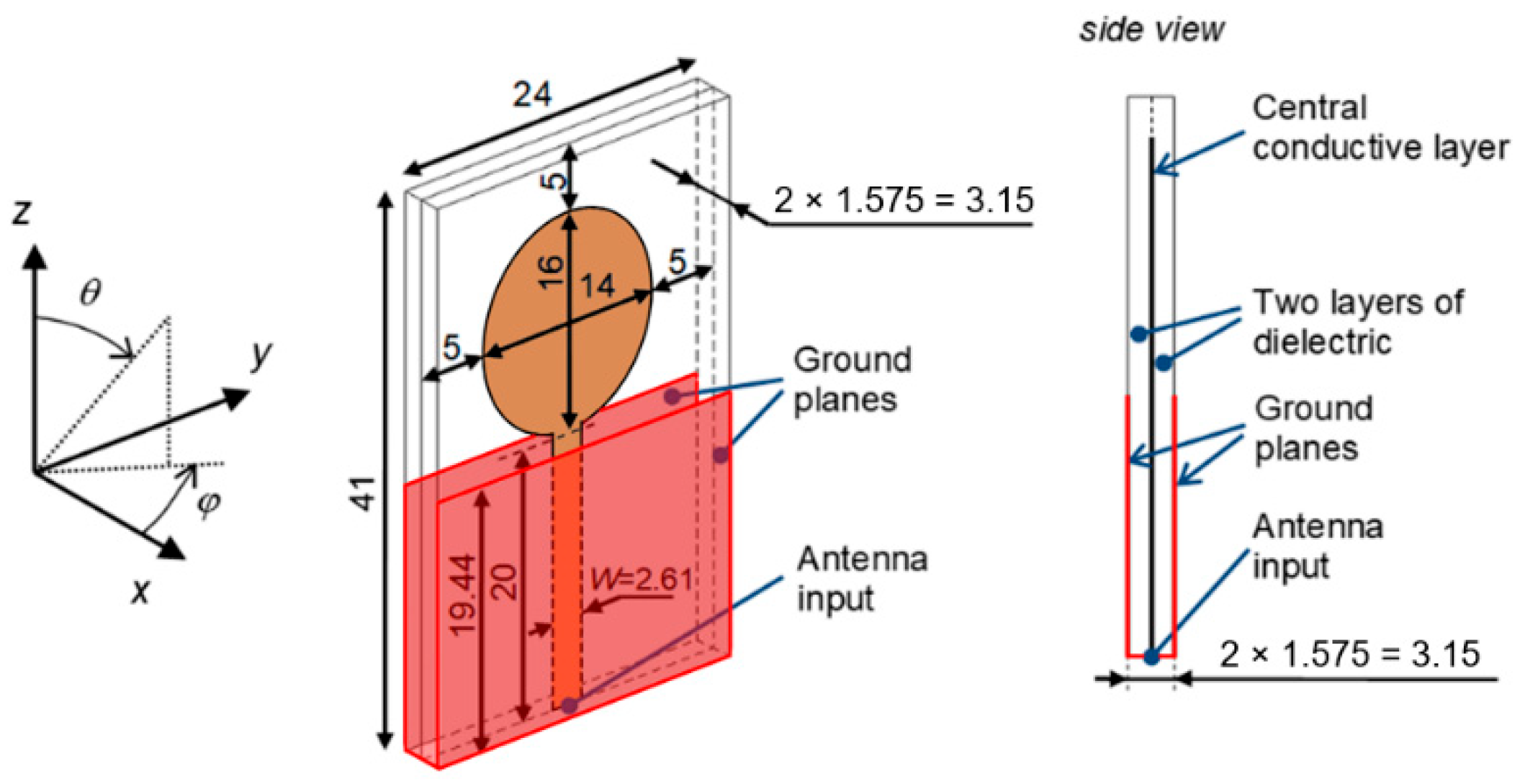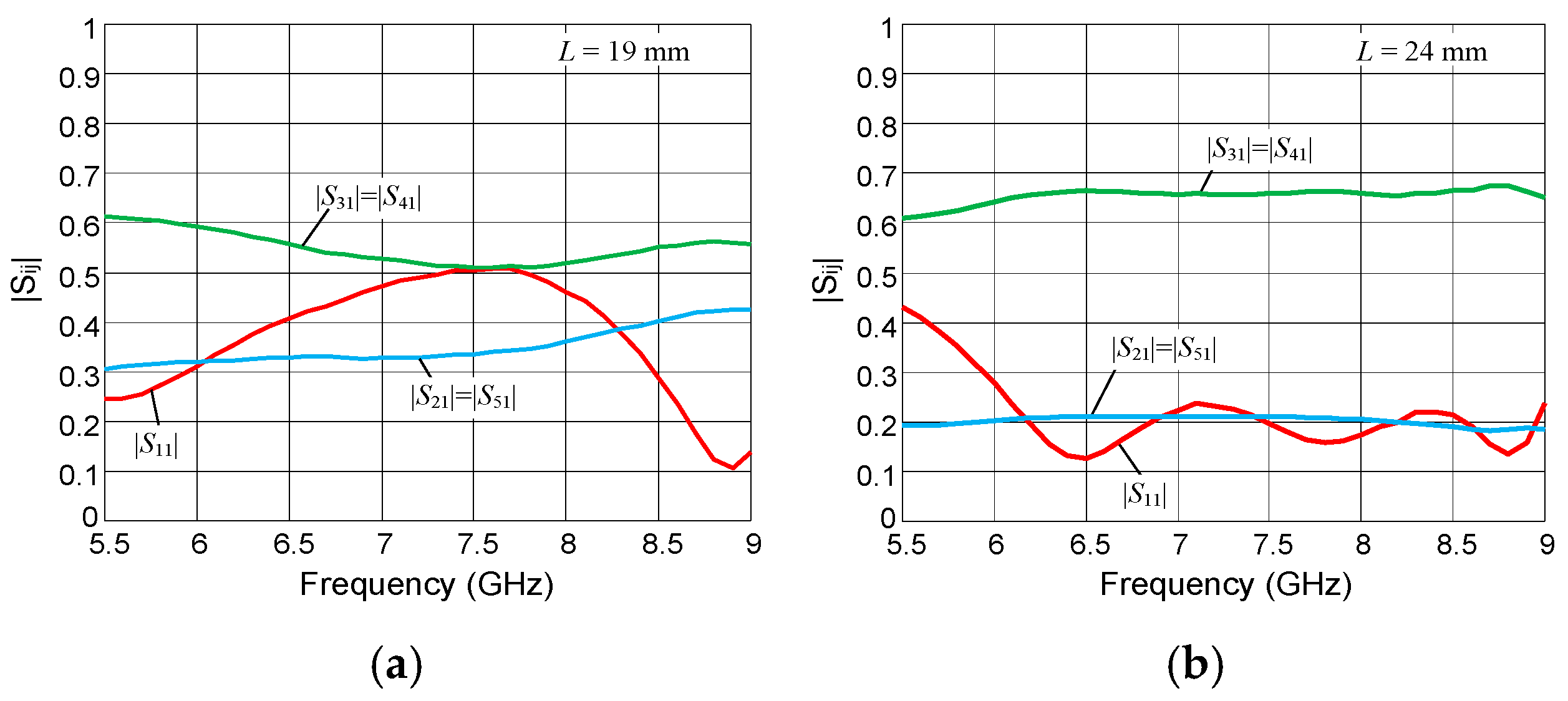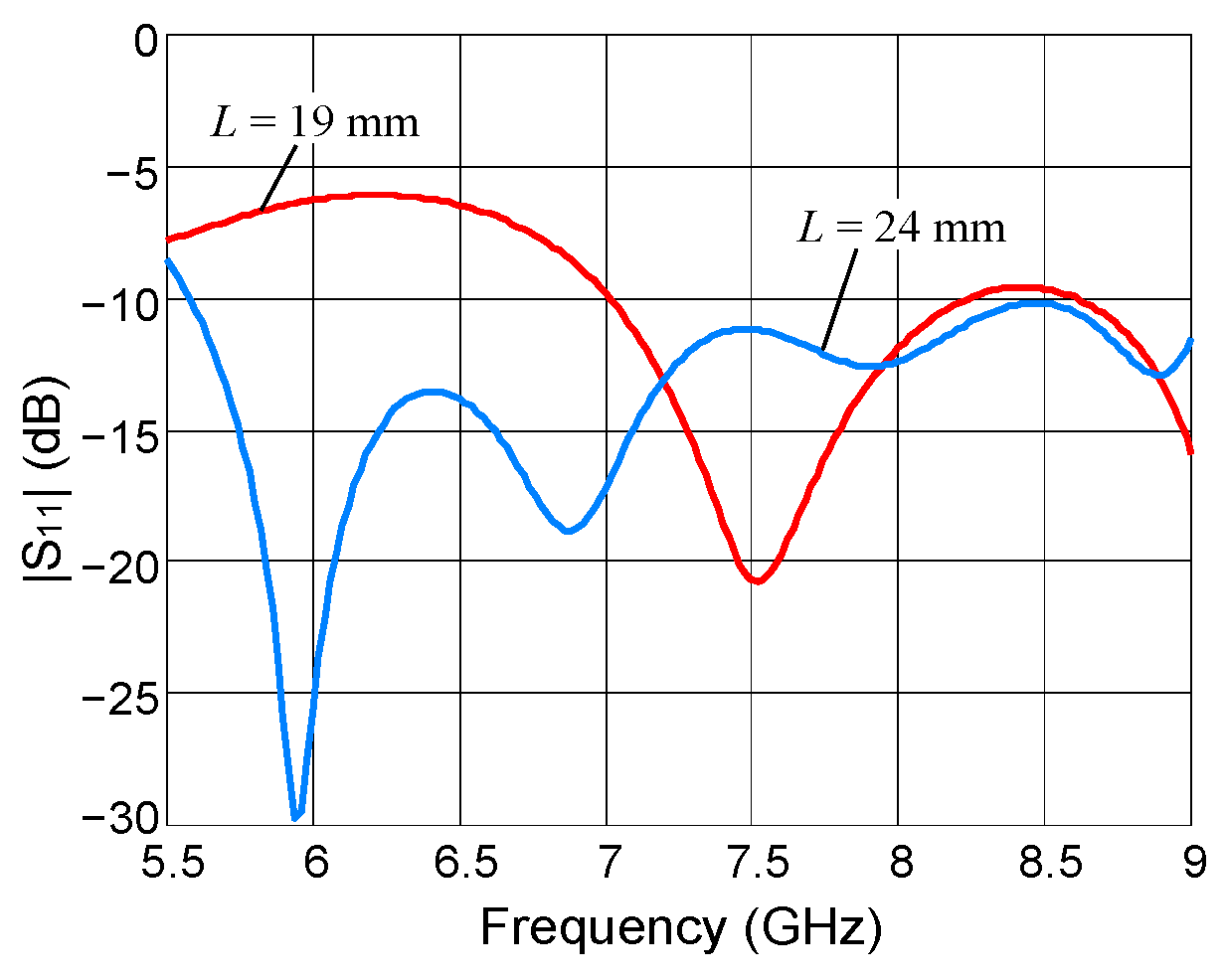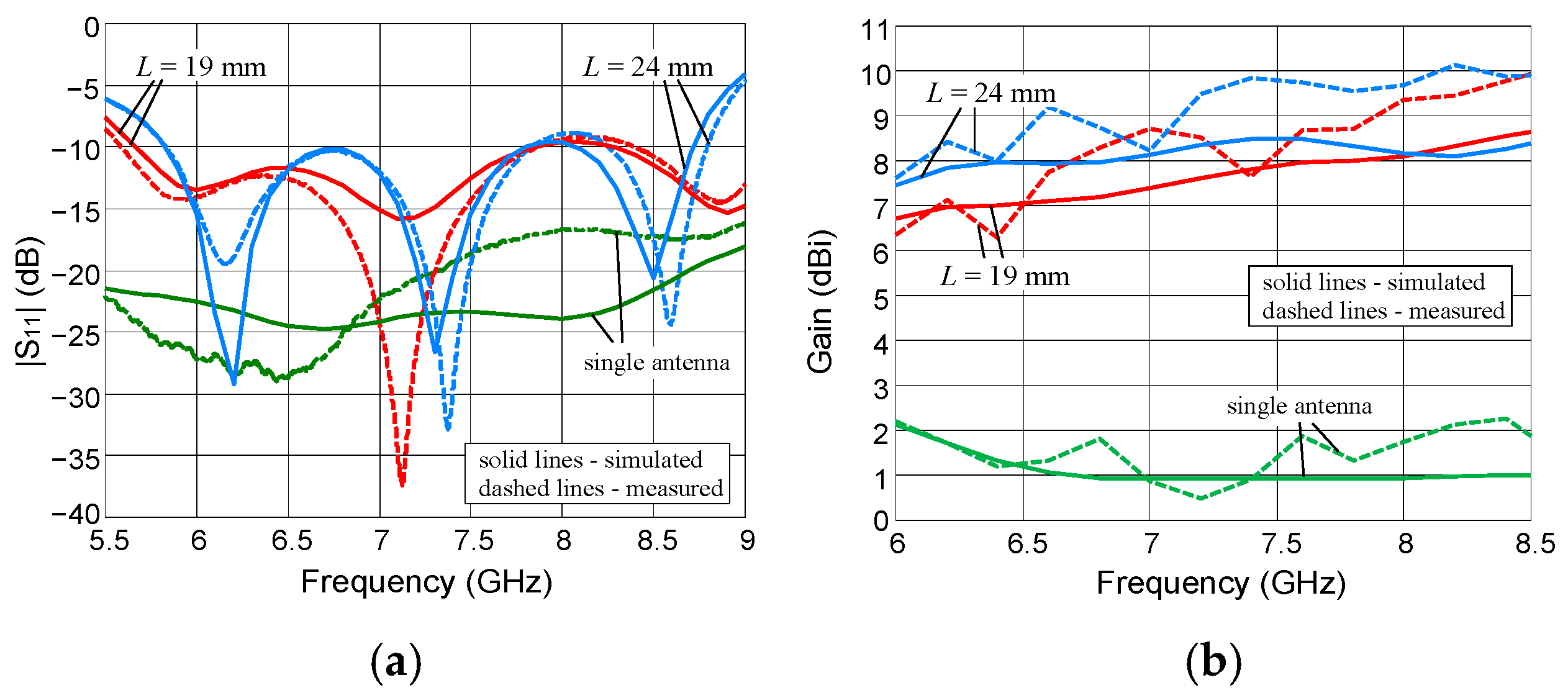Adaptation of Dolph–Chebyshev Method for Ultrawideband Antenna Array Design: A Novel Approach to Low-Sidelobe Arrays with 34.5% Fractional Bandwidths
Abstract
1. Introduction
- This work: 34.5% FBW (38–245% bandwidth increase).
- Significance: Required developing novel adaptation techniques, not just applying classical theory.
- Existing literature: Presents final designs without systematic procedures.
- This work: First published step-by-step methodology with Powell algorithm details.
- Enables reproducibility and extension by other researchers.
- Goes beyond reporting performance to systematically identify fundamental barriers.
- Comparative analysis (array variant 19 mm vs. 24 mm) demonstrates methodology sensitivity.
- Provides design guidelines for practitioners.
2. Materials and Methods
2.1. Prototype Single Antenna Design
2.2. Four-Element Antenna Arrays’ Structures
2.3. Theoretical Foundation: Dolph-Chebyshev Method Adaptation
2.4. Novel Two-Phase Adaptation Methodology
2.4.1. Phase 1: Dolph–Chebyshev-Inspired Feeding Network Optimization
2.4.2. Phase 2: Complete Array Optimization with Radiators
2.5. Design Procedure and Optimization
2.5.1. Phase 1: Feeding Network Optimization
2.5.2. Phase 2: Complete Array Optimization
2.6. Simulation Tools and Methods
2.7. Antenna Fabrication
2.8. Measurement Setup
3. Results
3.1. Phase 1 Results: Feeding Network Characteristics
3.2. Input Impedance Matching and Peak Gain
3.3. Radiation Patterns
3.4. Sidelobe Level Performance
3.5. Extended Experimental Validation
3.6. Comparative Analysis with State-of-the-Art
- Fractional bandwidth: [67] = 22.2% FBW vs. this work = 34.5% FBW (55% wider relative bandwidth).
- Fundamental relationship: Wider bandwidth exacerbates frequency-dependent effects (electrical spacing varies 42% vs. ~22% in [67]).
- Structural complexity: [67] uses a perpendicular reflector (3D structure) vs. a planar two-layer design here.
- Radiation characteristics: [67] half-space radiation vs. bidirectional radiation in this work.
- Widest documented FBW (34.5%) for Dolph–Chebyshev-based UWB arrays.
- Complete, systematic optimization methodology (first published detailed procedure).
- Planar, low-cost fabrication (simple two-layer vs. complex 3D).
- Bidirectional radiation (no reflector limitations).
- Explicit identification of physical limitations (quantifies fundamental trade-offs).
4. Discussion
4.1. Physical Limitations and Performance Boundaries
- Comprehensive analysis identifying three fundamental physical limitations:
- Frequency-dependent electrical spacing (42% variation, making optimal SLL mathematically impossible).
- Dynamic mutual coupling effects vary across a 2.5 GHz bandwidth.
- Amplitude-matching trade-offs between desired distribution and wideband impedance matching.
4.2. Gain Reduction: An Unavoidable Trade-off
- Comprehensive analysis including:
- Quantitative data: 0.3–0.7 dB gain reduction for the shorter variant, 0.2–0.4 dB for the longer variant.
- Physical explanation: Energy redistribution from the main beam to suppress sidelobes.
- Practical implications: Impact on link budget.
- Design guidance: System designers must explicitly evaluate whether the SLL improvement (4.1–10.2 dB) justifies the gain penalty for their specific application.
4.3. Comparison with Physical Suppression Techniques
- Quantitative comparison with 5 key metrics: SLL improvement, fractional bandwidth, gain penalty, structural complexity, and profile thickness.
- Key finding: This work achieved 34.5% FBW versus 8–18% for EBG/DGS approaches.
- Hybrid approach potential: Discussion of combining amplitude tapering with physical suppression to potentially achieve cumulative −18 to −20 dB SLL.
4.4. Comparison with State-of-the-Art
4.5. Practical Implications
4.6. Two-Phase Methodology Assessment
4.7. Limitations and Challenges
4.8. Validation of the Adaptation Concept
5. Conclusions
- Phase 1 utilized the Powell algorithm to account for mutual coupling and impedance transformation.
- Phase 2 employed multi-parameter optimization of the feeding network to ensure stable wideband impedance matching while preserving the required amplitude distribution.
Funding
Data Availability Statement
Conflicts of Interest
References
- Balanis, C.A. Antenna Theory: Analysis and Design; John Wiley & Sons: Hoboken, NJ, USA, 2016. [Google Scholar]
- Federal Communications Commission. The Federal Communications Commission Revision of Part 15 of the Commission’s Rules Regarding Ultrawideband Transmission Systems From 3.1 to 10.6 GHz; Federal Communications Commission: Washington, DC, USA, 2002. [Google Scholar]
- The European Commission. Commission Implementing Decision (EU) 2019/785 on the Harmonisation of Radio Spectrum for Equipment Using Ultra-Wideband Technology in the Union and Repealing Decision 2007/131/EC (Notified under Document C(2019) 3461); Official Journal of the European Union: Brussels, Belgique, 2019. [Google Scholar]
- Agarwal, S.; Rafique, U.; Ullah, R.; Ullah, S.; Khan, S.; Donelli, M. Double Overt-Leaf Shaped CPW-Fed Four Port UWB MIMO Antenna. Electronics 2021, 10, 3140. [Google Scholar] [CrossRef]
- Kumar, P.; Urooj, S.; Malibari, A. Design of Quad-Port Ultra-Wideband Multiple-Input-Multiple-Output Antenna with Wide Axial-Ratio Bandwidth. Sensors 2020, 20, 1174. [Google Scholar] [CrossRef]
- Bilal, M.; Shahid, S.; Khan, Y.; Rauf, Z.; Wagan, R.A.; Butt, M.A.; Khonina, S.N.; Kazanskiy, N.L. A Miniaturized FSS-Based Eight-Element MIMO Antenna Array for Off/On-Body WBAN Telemetry Applications. Electronics 2022, 11, 522. [Google Scholar] [CrossRef]
- Pandya, K.; Upadhyaya, T.; Patel, U.; Sorathiya, V.; Pandya, A.; Al-Gburi, A.J.A.; Ismail, M.M. Performance Analysis of Quad-Port UWB MIMO Antenna System for Sub-6 GHz 5G, WLAN and X-Band Communications. Results Eng. 2024, 22, 102318. [Google Scholar] [CrossRef]
- Pandya, K.; Upadhyaya, T.; Sorathiya, V.; Patel, U.; Pandya, A.; Al-Zahrani, F. Highly Isolated Electrically Compact UWB MIMO Antenna for Wireless Communications Applications. Results Eng. 2024, 24, 103082. [Google Scholar] [CrossRef]
- Arumugam, S.; Manoharan, S.; Palaniswamy, S.K.; Kumar, S. Design and Performance Analysis of a Compact Quad-Element UWB MIMO Antenna for Automotive Communications. Electronics 2021, 10, 2184. [Google Scholar] [CrossRef]
- Alibakhshikenari, M.; Virdee, B.S.; Shukla, P.; See, C.H.; Abd-Alhameed, R.; Khalily, M.; Falcone, F.; Limiti, E. Antenna Mutual Coupling Suppression Over Wideband Using Embedded Periphery Slot for Antenna Arrays. Electronics 2018, 7, 198. [Google Scholar] [CrossRef]
- Kumar, P.; Urooj, S.; Alrowais, F. Design and Implementation of Quad-Port MIMO Antenna with Dual-Band Elimination Characteristics for Ultra-Wideband Applications. Appl. Sci. 2020, 10, 1715. [Google Scholar] [CrossRef]
- Jia, Y.; Xu, P.; Guo, X. MIMO System Capacity Based on Different Numbers of Antennas. Results Eng. 2022, 15, 100577. [Google Scholar] [CrossRef]
- Kumar, J.; Gupta, A.; Tanwar, S.; Khan, M.K. A Review on 5G and Beyond Wireless Communication Channel Models: Applications and Chalenges. Phys. Commun. 2024, 67, 102488. [Google Scholar] [CrossRef]
- Zhai, B.; Tang, A.; Huang, C.; Han, C.; Wang, X. Antenna Subarray Management for Hybrid Beamforming in Millimeter-Wave Mesh Backhaul Networks. Phys. Commun. 2019, 19, 92–101. [Google Scholar] [CrossRef]
- Gaya, A.; Jamaluddin, M.H.; Alali, B. A Novel Wide Dual-Band Circularly Polarized Dielectric Resonator Antenna for Millimeter-Wave 5G Applications. Alexandria Eng. J. 2022, 61, 10791–10803. [Google Scholar] [CrossRef]
- Mohammed, A.S.B.; Kamal, S.; Ain, M.F.B.; Hussin, R.; Najmi, F.; Sundi (Suandi), S.A.; Ahmad, Z.A.; Ullah, U.; Omar, M.F.B.M.; Othman, M. Mathematical Model on the Effects of Conductor Thickness on Microstrip Patch Antenna for 5G Application. Alex. Eng. J. 2021, 60, 5265–5273. [Google Scholar] [CrossRef]
- Krishnamurthy, S.; Paramasivam, J. Compact Coradiator Dual Polarized MIMO Antenna for Future 5G, Emerging 6G and IoT Applications. Eng. Sci. Technol. Int. J. 2024, 51, 101609. [Google Scholar] [CrossRef]
- Abbas, A.; Hussain, N.; Sufian, M.A.; Awan, W.A.; Jung, J.; Lee, S.M.; Kim, N. Highly Selective Multiple-Notched UWB-MIMO Antenna with Low Correlation Using Innovative Parasitic Decoupling Structure. Eng. Sci. Technol. Int. J. 2023, 43, 101440. [Google Scholar] [CrossRef]
- Shobana, M. CSRR-Inspired Antenna Using Artificial Neural Network Optimization for Sub-6 GHz 5G Applications. Alex. Eng. J. 2023, 77, 351–367. [Google Scholar] [CrossRef]
- Ahmad, I.; Tan, W.; Ali, Q.; Sun, H. Latest Performance Improvement Strategies and Techniques Used in 5G Antenna Designing Technology, a Comprehensive Study. Micromachines 2022, 13, 717. [Google Scholar] [CrossRef]
- Park, S.-J.; Shin, D.-H.; Park, S.-O. Low Side-Lobe Substrate Integrated-Waveguide Antenna Array Using Broadband Unequal Feeding Network for Millimeter-Wave Handset Device. IEEE Trans. Antennas Propag. 2015, 64, 923–932. [Google Scholar] [CrossRef]
- Ahmad, I.; Sun, H.; Rafique, U.; Yi, Z. Triangular Slot-Loaded Wideband Planar Rectangular Antenna Array for Millimeter-Wave 5G Applications. Electronics 2021, 10, 778. [Google Scholar] [CrossRef]
- Ullah, H.; Tahir, F.A. Broadband Planar Antenna Array for Future 5G Communication Standards. IET Microw. Antennas Propag. 2019, 13, 2661–2668. [Google Scholar] [CrossRef]
- Munir, M.E.; Al Harbi, A.G.; Kiani, S.H.; Marey, M.; Parchin, N.O.; Khan, J.; Mostafa, H.; Iqbal, J.; Khan, M.A.; See, C.H.; et al. A New mm-Wave Antenna Array with Wideband Characteristics for Next Generation Communication Systems. Electronics 2022, 11, 1560. [Google Scholar] [CrossRef]
- De, D.; Shau, P.K. Design and Development of Multi-Port Switchable Power Dividers for Antenna Feeding Networks. AEU—Int. J. Electron. Commun. 2018, 96, 184–192. [Google Scholar] [CrossRef]
- Tan, W.; Xiao, Y.; Li, C.; Zhu, K.; Luo, H.; Sun, H. A Wide-Band High-Efficiency Hybrid-Feed Antenna Array for mm-Wave Wireless Systems. Electronics 2021, 10, 2383. [Google Scholar] [CrossRef]
- Lee, S.; Lee, Y.; Shin, H. A 28-GHz Switched-Beam Antenna with Integrated Butler Matrix and Switch for 5G Applications. Sensors 2021, 21, 5128. [Google Scholar] [CrossRef] [PubMed]
- Kim, S.; Yoon, S.; Lee, Y.; Shin, H. A Miniaturized Butler Matrix Based Switched Beamforming Antenna System in a Two-Layer Hybrid Stackup Substrate for 5G Applications. Electronics 2019, 8, 1232. [Google Scholar] [CrossRef]
- Khalily, M.; Tafazolli, R.; Xiao, P.; Kishk, A.A. Broadband mm-Wave Microstrip Array Antenna with Improved Radiation Characteristics for Different 5G Applications. IEEE Trans. Antennas Propag. 2018, 66, 4641–4647. [Google Scholar] [CrossRef]
- Park, J.; Seong, H.; Whang, Y.N.; Hong, W. Energy-Efficient 5G Phased Arrays Incorporating Vertically Polarized Endfire Planar Folded Slot Antenna for mmWave Mobile Terminals. IEEE Trans. Antennas Propag. 2020, 68, 230–241. [Google Scholar] [CrossRef]
- Wei, F.; Wang, J.X.; Zhao, X.B.; Zeng, C.; Hou, J.Q. Balanced-to-Single-Ended Four-Way out-of-Phase Power Divider and Its Application to Broadband Balanced Quasi-Yagi Antenna Array. IEEE Antennas Wirel. Propag. Lett. 2020, 19, 1370–1374. [Google Scholar] [CrossRef]
- Patel, A.; Desai, A.; Elfergani, I.; Vala, A.; Mewada, H.; Mahant, K.; Patel, S.; Zebiri, C.; Rodriguez, J.; Ali, E. UWB CPW-Fed 4-Port Connected Ground MIMO Antenna for Sub-Millimeter-Wave 5G Applications. Alex. Eng. J. 2022, 61, 6645–6658. [Google Scholar] [CrossRef]
- Yahya, M.S.; Soeung, S.; Abdul Rahim, S.K.; Musa, U.; Ba Hashwan, S.S.; Yunusa, Z.; Hamzah, S.A. LoRa Microstrip Patch Antenna: A comprehensive review. Alex. Eng. J. 2024, 103, 197–221. [Google Scholar] [CrossRef]
- Patel, S.K.; Baz, A.; Agravat, D. Design of Machine Learning Optimized THz MIMO Antenna for Next-Generation Wireless Communication Systems. Ain Shams Eng. J. 2025, 16, 103384. [Google Scholar] [CrossRef]
- Alwareth, H.; Ibrahim, I.M.; Zakaria, Z.; Al-Gburi, A.J.A.; Ahmed, S.; Nasser, Z.A. A Wideband High-Gain Microstrip Array Antenna Integrated with Frequency-Selective Surface for Sub-6 GHz 5G Applications. Micromachines 2022, 13, 1215. [Google Scholar] [CrossRef] [PubMed]
- Ishfaq, M.K.; Rahman, T.A.; Himdi, M.; Chattha, H.T.; Saleem, Y.; Khawaja, B.A.; Masud, F. Compact Four-Element Phased Antenna Array for 5G Applications. IEEE Access 2019, 7, 161103–161111. [Google Scholar] [CrossRef]
- Barani, I.R.R.; Wong, K.-L.; Zhang, Y.-X.; Li, W.-Y. Low-Profile Wideband Conjoined Open-Slot Antennas Fed by Grounded Coplanar Waveguides for 4×4 5G MIMO Operation. IEEE Trans. Antennas Propag. 2020, 68, 2646–2657. [Google Scholar] [CrossRef]
- Fang, X.; Wen, G.; Inserra, D.; Huang, Y.; Li, J. Compact Wideband CPW-Fed Meandered-Slot Antenna with Slotted Y-Shaped Central Element for Wi-Fi, WiMAX, and 5G Applications. IEEE Trans. Antennas Propag. 2018, 66, 7395–7399. [Google Scholar] [CrossRef]
- Li, Y.; Zhao, Z.; Tang, Z.; Yin, Y. Differentially Fed, Dual-Band Dual-Polarized Filtering Antenna with High Selectivity for 5G Sub-6 GHz Base Station Applications. IEEE Trans. Antennas Propag. 2020, 68, 3231–3236. [Google Scholar] [CrossRef]
- Wei, F.; Liu, X.; Ding, X.Z.; Zhao, X.B.; Qin, P.Y. A Balanced Filtering Antenna Array with High Gain, Steep Selectivity, and Multiradiation Nulls Parallel-Fed by Differential Broadband Network. IEEE Trans. Antennas Propag. 2023, 71, 9926–9931. [Google Scholar] [CrossRef]
- Rahman, M.; NaghshvarianJahromi, M.; Mirjavadi, S.S.; Hamouda, A.M. Bandwidth Enhancement and Frequency Scanning Array Antenna Using Novel UWB Filter Integration Technique for OFDM UWB Radar Applications in Wireless Vital Signs Monitoring. Sensors 2018, 18, 3155. [Google Scholar] [CrossRef]
- Mahmud, M.Z.; Islam, M.T.; Misran, N.; Singh, M.J.; Mat, K. A Negative Index Metamaterial to Enhance the Performance of Miniaturized UWB Antenna for Microwave Imaging Applications. Appl. Sci. 2017, 7, 1149. [Google Scholar] [CrossRef]
- Song, C.; Pan, L.; Jiao, Y.; Jia, J. A High-Performance Transmitarray Antenna with Thin Metasurface for 5G Communication Based on PSO (Particle Swarm Optimization). Sensors 2020, 20, 4460. [Google Scholar] [CrossRef]
- Alibakhshikenari, M.; Virdee, B.S.; See, C.H.; Abd-Alhameed, R.A.; Falcone, F.; Limiti, E. Super-Wide Impedance Bandwidth Planar Antenna for Microwave and Millimeter-Wave Applications. Sensors 2019, 19, 2306. [Google Scholar] [CrossRef]
- Tariq, S.; Naqvi, S.I.; Hussain, N.; Amin, Y. A Metasurface-Based MIMO Antenna for 5G Millimeter-Wave Applications. IEEE Access 2021, 9, 51805–51817. [Google Scholar] [CrossRef]
- de Cos Gómez, M.E.; Fernández Álvarez, H.; Flórez Berdasco, A.; Las-Heras Andrés, F. Compact Wearable Antenna with Metasurface for Millimeter-Wave Radar Applications. Materials 2023, 16, 2553. [Google Scholar] [CrossRef]
- Patwary, A.B.; Mahbub, I. 4×4 UWB Phased Array Antenna WITH >51° Far-Field Scanning Range for Wireless Power Transfer Application. IEEE Open J. Antennas Propag. 2024, 5, 354–367. [Google Scholar] [CrossRef]
- Wang, S.; Wang, W.; Chung, K.L.; Zheng, Y. An Orthogonal Quad-Beam Scanning Antenna Using 1-Bit Dielectric Modulation in Plasmonic Metamaterial Transmission Line for Traffic Monitoring Applications. IEEE Trans. Veh. Technol. 2025, 1–11, early access. [Google Scholar] [CrossRef]
- Yuan, H.; Li, J.; Zhao, Z.; Wang, Z.; Lodi, M.B.; Gugliandolo, G.; Donato, N.; Crupi, G.; Si, L.; Bao, X. Development of a Wideband Slotted Antenna Array with Low Profile and Low Sidelobe. Electronics 2023, 12, 278. [Google Scholar] [CrossRef]
- Uddin, M.N.; Choi, S. Non-Uniformly Powered and Spaced Corporate Feeding Power Divider for High-Gain Beam with Low SLL in Millimeter-Wave Antenna Array. Sensors 2020, 20, 4753. [Google Scholar] [CrossRef]
- Jiang, X.; Jia, F.; Cao, Y.; Huang, P.; Yu, J.; Wang, X.; Shi, Y. Ka-Band 8 × 8 Low-Side lobe Slot Antenna Array using a 1-to-64 High-Efficiency Network Designed by New Printed RGW Technology. IEEE Antennas Wirel. Propag. Lett. 2019, 18, 1248–1252. [Google Scholar] [CrossRef]
- Juárez, E.; Panduro, M.A.; Reyna, A.; Covarrubias, D.H.; Mendez, A.; Murillo, E. Design of Concentric Ring Antenna Arrays Based on Subarrays to Simplify the Feeding System. Symmetry 2020, 12, 970. [Google Scholar] [CrossRef]
- Panduro, M.A.; Reyna, A.; Covarrubias, D.H. Non-Uniform Concentric Rings Design for Ultra-Wideband Arrays. Sensors 2019, 19, 2262. [Google Scholar] [CrossRef] [PubMed]
- Albagory, Y.; Alraddady, F. An Efficient Approach for Sidelobe Level Reduction Based on Recursive Sequential Damping. Symmetry 2021, 13, 480. [Google Scholar] [CrossRef]
- Wang, J.; Cui, W.; Zhou, Y.; Liu, R.; Wang, M.; Fan, C.; Zheng, H.; Li, E. Design of Wideband Antenna Array with Dielectric Lens and Defected Ground Structure. Electronics 2021, 10, 2066. [Google Scholar] [CrossRef]
- Bouchachia, I.; Reddaf, A.; Boudjerdab, M.; Alhassoon, K.; Babes, B.; Alsunaydih, F.N.; Ali, E.; Alsharef, M.; Alsaleem, F. Design and Performance Improvement of an UWB Antenna with DGS Structure Using Grey Wolf Optimization Algorithm. Heliyon 2024, 10, e26337. [Google Scholar] [CrossRef] [PubMed]
- Natarajan, P.; Sigamani, T. Design Implementation Analysis of Multi-Band Antenna for Terrestrial Applications. Heliyon 2024, 10, e37519. [Google Scholar] [CrossRef]
- Abdulhameed, M.K.; Isa Mohd saari, B.M.; Zakaria, Z.; Ibrahim, I.M.; Mohsen, M.K.; Attiah, M.L.; Dinar, A.M. Enhanced Performance of Compact 2 × 2 Antenna Array with Electromagnetic Band-Gap. Microw. Opt. Technol. Lett. 2020, 62, 875–886. [Google Scholar] [CrossRef]
- Pandhare, R.A.; Zade, P.L.; Abegaonkar, M.P. Miniaturized Microstrip Antenna Array Using Defected Ground Structure with Enhanced Performance. Eng. Sci. Technol. Int. J. 2016, 19, 1360–1367. [Google Scholar] [CrossRef]
- Yang, X.; Zhang, X.; Liao, Z. A Novel Planar Four-Way Power Divider with Large Dividing Ratio. AEU—Int. J. Electron. Commun. 2018, 85, 1–6. [Google Scholar] [CrossRef]
- Mao, C.-X.; Khalily, M.; Xiao, P.; Brown, T.W.C.; Gao, S. Planar Sub-Millimeter-Wave Array Antenna with Enhanced Gain and Reduced Sidelobes for 5G Broadcast Applications. IEEE Trans. Antennas Propag. 2019, 67, 160–168. [Google Scholar] [CrossRef]
- Anim, K.; Danuor, P.; Park, S.-O.; Jung, Y.-B. High-Efficiency Broadband Planar Array Antenna with Suspended Microstrip Slab for X-Band SAR Onboard Small Satellites. Sensors 2022, 22, 252. [Google Scholar] [CrossRef]
- Kim, S.-W.; Choi, D.-Y. Analysis of Beamforming Antenna for Practical Indoor Location-Tracking Application. Sensors 2019, 19, 3040. [Google Scholar] [CrossRef]
- Liu, J.; Yang, F.; Fan, K.; Jin, C. Unequal Power Divider Based on Inverted Microstrip Gap Waveguide and Its Application for Low Sidelobe Slot Array Antenna at 39 GHz. IEEE Trans. Antenna Propag. 2021, 69, 8415–8425. [Google Scholar] [CrossRef]
- Hossain, M.M.; Alam, M.J.; Latif, S.I. Orthogonal Printed Microstrip Antenna Arrays for 5G Millimeter-Wave Applications. Micromachines 2022, 13, 53. [Google Scholar] [CrossRef]
- Falahati, A.; NaghshvarianJahromi, M.; Edwards, R.M. Wideband Fan-Beam Low-Sidelobe Array Antenna Using Grounded Reflector for DECT, 3G, and Ultra-Wideband Wireless Applications. IEEE Trans. Antenna Propag. 2013, 61, 700–706. [Google Scholar] [CrossRef]
- Ali Amer, M.; Abdalla, M.M.; Abograin, A.A. Wideband Angled Dipole Array Antenna with a Suppressed Sidelobe Levels For Beamforming Applications. In Proceedings of the 2022 IEEE 2nd International Maghreb Meeting of the Conference on Sciences and Techniques of Automatic Control and Computer Engineering (MI-STA), Sabratha, Libya, 23–25 May 2022; pp. 485–491. [Google Scholar] [CrossRef]
- Garbaruk, M. A Planar Four-Element UWB Antenna Array with Stripline Feeding Network. Electronics 2022, 11, 469. [Google Scholar] [CrossRef]
- Jaradat, H.; Dib, N.; Al Shamaileh, K. Miniaturized Dual-Band CPW Wilkinson Power Divider Using T-Network with High Frequency Ratio. AEU—Int. J. Electron. Commun. 2019, 107, 32–38. [Google Scholar] [CrossRef]
- Wu, S.; Li, J.; Wang, J.; Cao, Y.; Zhou, H. Millimeter-Wave 3DPrinted Filtering Power Divider with High Frequency Selectivity and Enhanced Heat Dispersion. AEU—Int. J. Electron. Commun. 2024, 177, 155200. [Google Scholar] [CrossRef]
- Yang, S.; Wang, X.; Zhu, L.; Gao, X.; Li, K.; Shulga, V.; Lu, G. A Novel Power Divider with Arbitrary Power Ratio, Arbitrary Phase Difference and Controllable Bandwidths. AEU—Int. J. Electron. Commun. 2023, 170, 154773. [Google Scholar] [CrossRef]
- Alazemi, A.; Kourah, M.; Al-Zayed, A. A Reconfigurable Five-Port Power Divider with Power Routing Versatility. AEU—Int. J. Electron. Commun. 2019, 110, 152832. [Google Scholar] [CrossRef]
- Karimi, G.; Siahkamari, H.; Khamin-Hamedani, F. A Novel Miniaturized Gysel Power Divider Using LowPass Filter with Harmonic Suppression. AEU—Int. J. Electron. Commun. 2015, 69, 856–860. [Google Scholar] [CrossRef]
- Pallavi, M.; Kumar, P.; Ali, T.; Shenoy, S.B.; Shivakumar, B.R. Design and Validation of a Miniaturized Reconfigurable Power Divider with Arbitrary Power Split Ratio and Flexible Output Phase Difference. AEU—Int. J. Electron. Commun. 2024, 183, 155373. [Google Scholar] [CrossRef]
- Hu, B.; Song, K.; Fan, M.; Zhu, Y. Compact Reconfigurable Power Divider with Low Insertion Loss. AEU—Int. J. Electron. Commun. 2016, 70, 786–789. [Google Scholar] [CrossRef]
- Sun, M.; Xiang, Q.; Fu, M.; Feng, Q. Novel Gysel Power Dividers with Tunable Power Dividing Ratio and Central Frequency. AEU—Int. J. Electron. Commun. 2022, 156, 154382. [Google Scholar] [CrossRef]











| Parameter | Classical D-C Assumption | UWB Array Reality (This Work) |
|---|---|---|
| electrical spacing variation | <5% | 42% (0.38λ to 0.54λ and 0.48λ to 0.68λ) |
| fractional bandwidth | <10% | 34.5% |
| mutual coupling change | negligible | significant (varies with λ) |
| phase distribution | uniform/non-uniform | requires careful design |
| impedance matching | single-frequency | across 2.5 GHz band |
| Gain (dBi) | 6.0 (GHz) | 7.2 (GHz) | 8.4 (GHz) |
|---|---|---|---|
| Simulated/Measured | Simulated/Measured | Simulated/Measured | |
| uniform feeding, L = 19 mm [68] | 6.7/6.4 | 7.4/7.8 | 8.8/10.5 |
| non-uniform feeding, L = 19 mm | 6.7/6.4 | 7.6/8.5 | 8.5/9.8 |
| uniform feeding, L = 24 mm [68] | 8.4/8.5 | 8.9/8.6 | 9.3/10.8 |
| non-uniform feeding, L = 24 mm | 7.4/7.6 | 8.3/9.5 | 8.3/9.9 |
| SLL (dB) | 6.0 (GHz) | 7.2 (GHz) | 8.4 (GHz) |
|---|---|---|---|
| Simulated/Measured | Simulated/Measured | Simulated/Measured | |
| uniform feeding, L = 19 mm [68] | −11.0 */−7.0 | −13.0/−12.0 | −16.7/−15.6 |
| non-uniform feeding, L = 19 mm | −17.0/−11.8 | −27.3 */−15.8 | −22.1/−17.6 |
| uniform feeding, L = 24 mm [68] | −12.5/−11.5 | −14.6/−14.6 | −12.5/−12.9 |
| non-uniform feeding, L = 24 mm | −39.5 */−20.0 | −24.8/−19.7 | −16.6/−17.2 |
| Antenna | Bandwidth (GHz) | Antenna Structure | Peak Gain (dBi) | SLL (dB) | Total Dimensions (mm3) |
|---|---|---|---|---|---|
| [67] | 5–8 | 1 × 4 | 7.5–9 | −22 | − |
| [36] | 5.7–6.8 | 1 × 4 | 8.4 | −6 | 59.9 × 22.8 × 1.8 |
| [55] | 7–11.2 | 1 × 4 | 8.4–12.4 | −8 | 43 × 72 × 0.762 |
| [24] | 26.5–37.5 | 1 × 4 | 9–11.5 | −9 | 18.25 × 12.5 × 0.254 |
| [23] | 24.3–39.3 | 1 × 4 | 8–11.5 | −10 | 40 × 15 × 0.254 |
| [66] | 1.7–2.2 | 1 × 6 | >7 | −16.7 | 517.5 × 99.5 × 60 |
| [61] | 24–29.5 | 1 × 8 | 7–13 | −15 | 66 × 15 × 0.3 |
| [21] | 27.2–29.5 | 1 × 8 | 14.9 | −20 | 70 × 63.5 × 2.199 |
| [50] | 26.8–29.6 | 1 × 12 | 17.1 | −16.6 | 70 × 57.3 × 1.254 |
| This work, shorter variant | 6–8.5 | 1 × 4 | 6.7–8.5 | −17 | 81 × 41 × 3.15 |
| This work, longer variant | 6–8.5 | 1 × 4 | 7.4–8.3 | −16.6 | 96 × 41 × 3.15 |
Disclaimer/Publisher’s Note: The statements, opinions and data contained in all publications are solely those of the individual author(s) and contributor(s) and not of MDPI and/or the editor(s). MDPI and/or the editor(s) disclaim responsibility for any injury to people or property resulting from any ideas, methods, instructions or products referred to in the content. |
© 2025 by the author. Licensee MDPI, Basel, Switzerland. This article is an open access article distributed under the terms and conditions of the Creative Commons Attribution (CC BY) license (https://creativecommons.org/licenses/by/4.0/).
Share and Cite
Garbaruk, M. Adaptation of Dolph–Chebyshev Method for Ultrawideband Antenna Array Design: A Novel Approach to Low-Sidelobe Arrays with 34.5% Fractional Bandwidths. Electronics 2025, 14, 4595. https://doi.org/10.3390/electronics14234595
Garbaruk M. Adaptation of Dolph–Chebyshev Method for Ultrawideband Antenna Array Design: A Novel Approach to Low-Sidelobe Arrays with 34.5% Fractional Bandwidths. Electronics. 2025; 14(23):4595. https://doi.org/10.3390/electronics14234595
Chicago/Turabian StyleGarbaruk, Marek. 2025. "Adaptation of Dolph–Chebyshev Method for Ultrawideband Antenna Array Design: A Novel Approach to Low-Sidelobe Arrays with 34.5% Fractional Bandwidths" Electronics 14, no. 23: 4595. https://doi.org/10.3390/electronics14234595
APA StyleGarbaruk, M. (2025). Adaptation of Dolph–Chebyshev Method for Ultrawideband Antenna Array Design: A Novel Approach to Low-Sidelobe Arrays with 34.5% Fractional Bandwidths. Electronics, 14(23), 4595. https://doi.org/10.3390/electronics14234595






